Ferocactus Cacti: 44 Types Unveiled with Care Instructions
Enter the world of Ferocactus – an extraordinary cactus with a barrel-like form, striking flowers, and formidable spines. From its shallow roots to its vibrant blooms, this captivating plant is adored for its mesmerizing beauty and has earned the title of “traveler’s friend.” Prepare to be amazed as we delve into the realm of Ferocactus, exploring various species, their unique traits, and the secrets to their care. Let’s embark on an adventure celebrating the awe-inspiring allure of Ferocactus!
Contents
- 1 Types of Ferocactus Cacti
- 1.1 Ferocactus alamosanus (Alamos Barrel Cactus)
- 1.2 Ferocactus chrysacanthus
- 1.3 Ferocactus chrysacanthus ssp. grandiflorus
- 1.4 Ferocactus cylindraceus (California Barrel Cactus)
- 1.5 Ferocactus cylindraceus ssp. lecontei
- 1.6 Ferocactus diguetii (Santa Catalina Barrel Cactus)
- 1.7 Ferocactus echidne
- 1.8 Ferocactus echidne var. victoriensis
- 1.9 Ferocactus emoryi (Emory’s Barrel Cactus)
- 1.10 Ferocactus emoryi ssp. rectispinus
- 1.11 Ferocactus flavovirens
- 1.12 Ferocactus fordii (Ford Barrel Cactus)
- 1.13 Ferocactus fordii ssp. borealis
- 1.14 Ferocactus gracilis (Fire Barrel Cactus)
- 1.15 Ferocactus gracilis ssp. coloratus
- 1.16 Ferocactus gracilis ssp. gatesii
- 1.17 Ferocactus gracilis ssp. tortulispinus
- 1.18 Ferocactus hamatacanthus (Turk’s head)
- 1.19 Ferocactus herrerae
- 1.20 Ferocactus histrix
- 1.21 Ferocactus latispinus (Devil’s Tongue Barrel Cactus)
- 1.22 Ferocactus macrodiscus
- 1.23 Ferocactus macrodiscus ssp. septentrionalis
- 1.24 Ferocactus peninsulae
- 1.25 Ferocactus peninsulae ssp. viscainensis
- 1.26 Ferocactus pilosus
- 1.27 Ferocactus pottsii
- 1.28 Ferocactus recurvus
- 1.29 Ferocactus recurvus ssp. greenwoodii
- 1.30 Ferocactus recurvus ssp. spiralis
- 1.31 Ferocactus reppenhagenii
- 1.32 Ferocactus robustus
- 1.33 Ferocactus santa-maria
- 1.34 Ferocactus schwarzii
- 1.35 Ferocactus stainesii
- 1.36 Ferocactus tiburonensis
- 1.37 Ferocactus townsendianus
- 1.38 Ferocactus townsendianus var. townsendianus
- 1.39 Ferocactus viridescens (San Diego Barrel Cactus)
- 1.40 Ferocactus viridescens ssp. littoralis
- 1.41 Ferocactus viridescens ssp. viridescens
- 1.42 Ferocactus viscainensis
- 1.43 Ferocactus wislizeni (Fishhook Barrel Cactus)
- 1.44 Ferocactus wislizeni ssp. ajoensis
- 2 How to Grow and Care For Ferocactus
- 3 Propagating Ferocactus
- 4 FAQs
- 5 Final Words
Types of Ferocactus Cacti
Ferocactus alamosanus (Alamos Barrel Cactus)
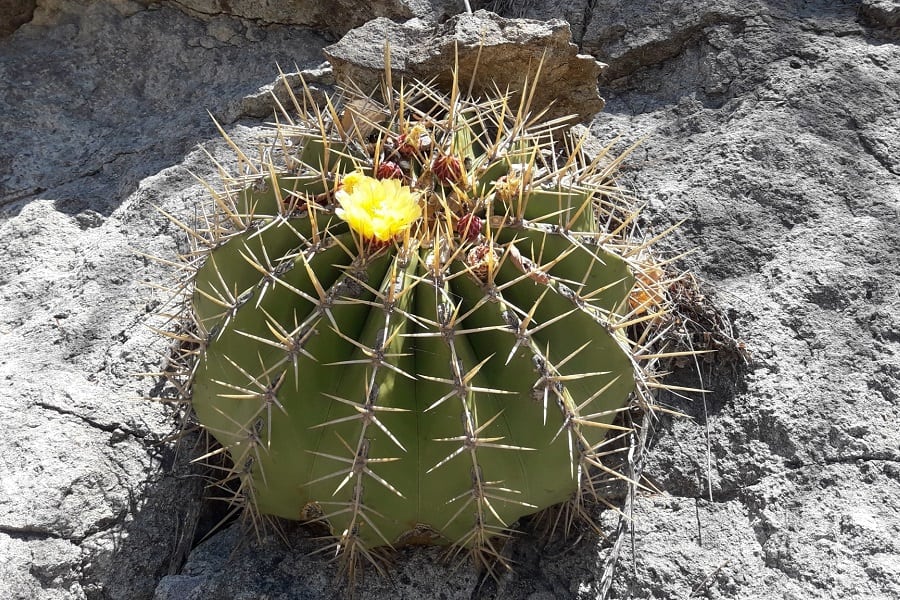
Ferocactus alamosanus is a small barrel-shaped cactus that usually grows alone, but sometimes in clusters.
Ferocactus chrysacanthus
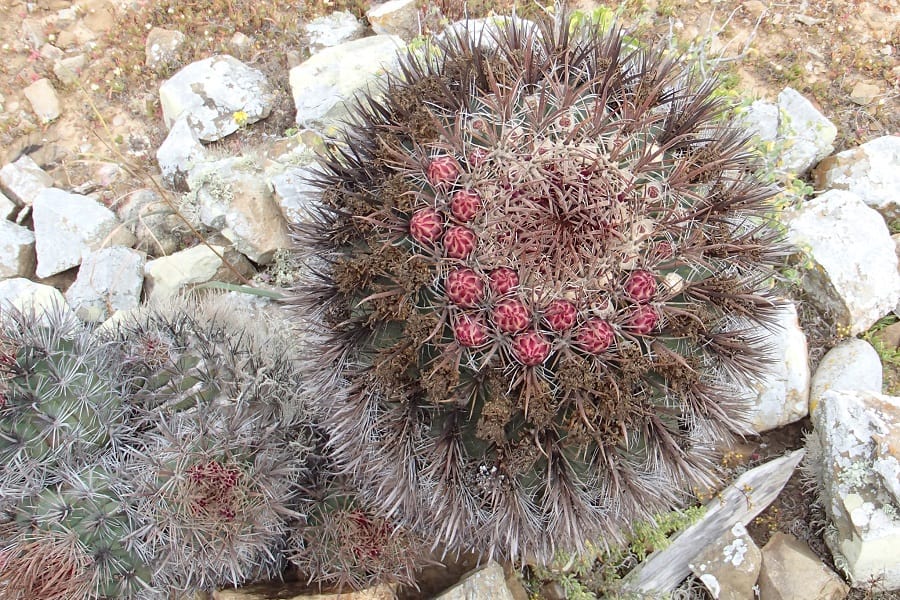
Ferocactus chrysacanthus is a small solitary cactus with up to 6 heads. It is densely covered in spines, making it tolerant of full sun.
Ferocactus chrysacanthus ssp. grandiflorus
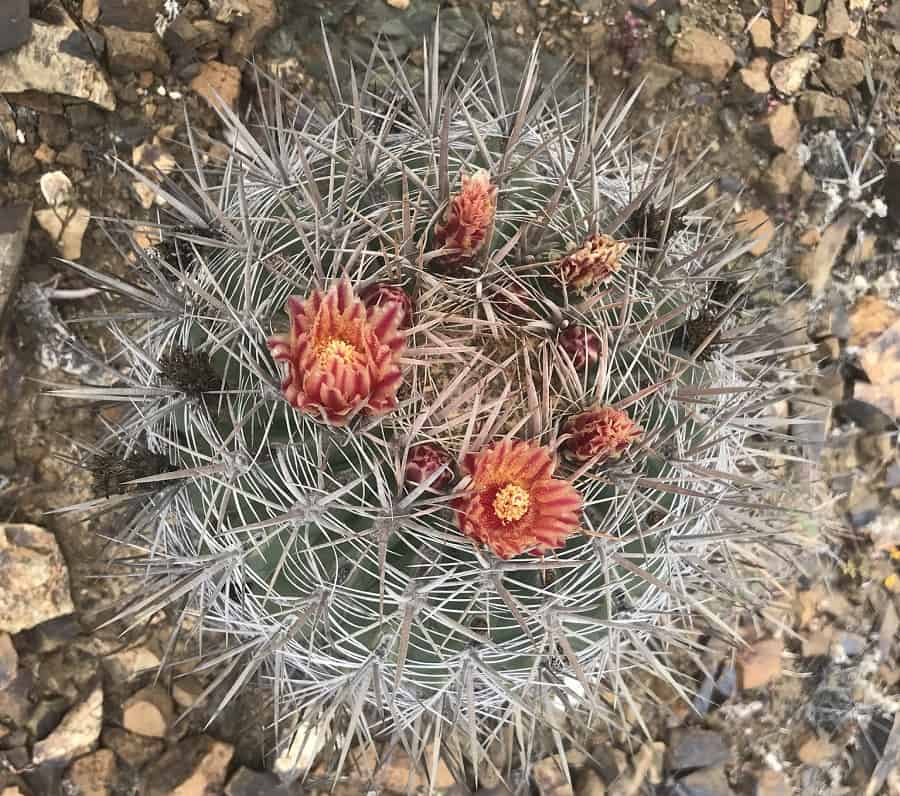
This subspecies of Ferocactus chrysacanthus has striking red or red-orange flowers.
Ferocactus cylindraceus (California Barrel Cactus)
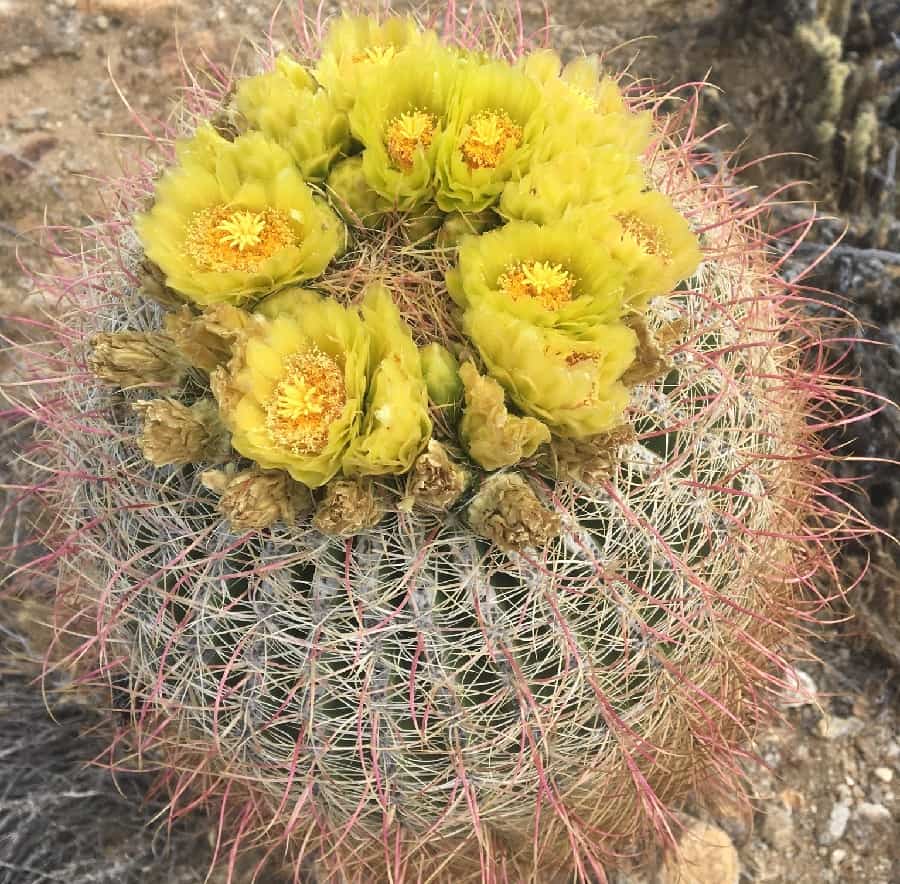
Ferocactus cylindraceus is a vibrant barrel cactus that usually grows as a single tall column. There are four recognized subspecies with slight variations in appearance.
Ferocactus cylindraceus ssp. lecontei
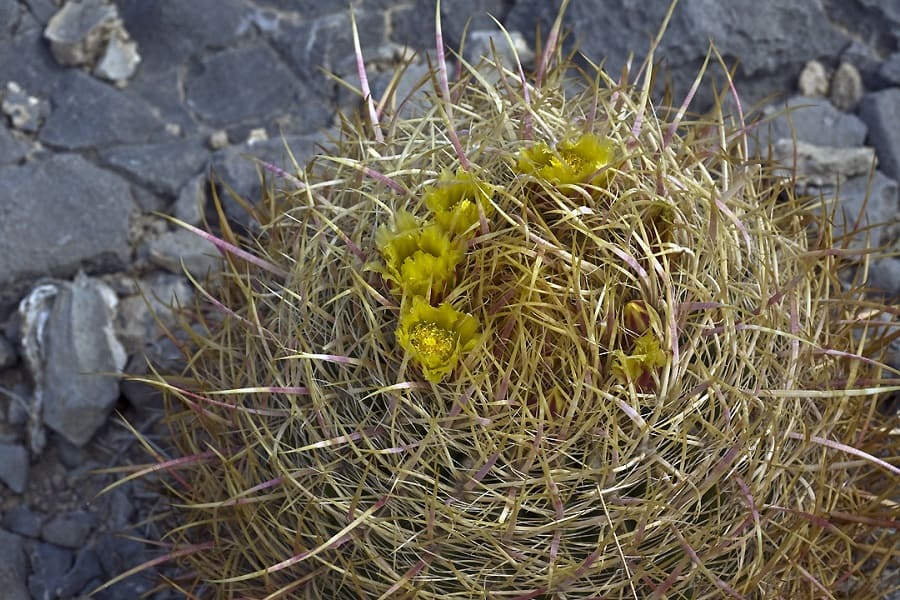
Ferocactus lecontei, along with Ferocactus tortulispinus and Ferocactus rostii, is a variant of Ferocactus cylindraceus. It grows as a single column up to 6.5 feet tall and 12 inches in diameter. The ribs are 1 inch high and tuberculate.
Ferocactus diguetii (Santa Catalina Barrel Cactus)
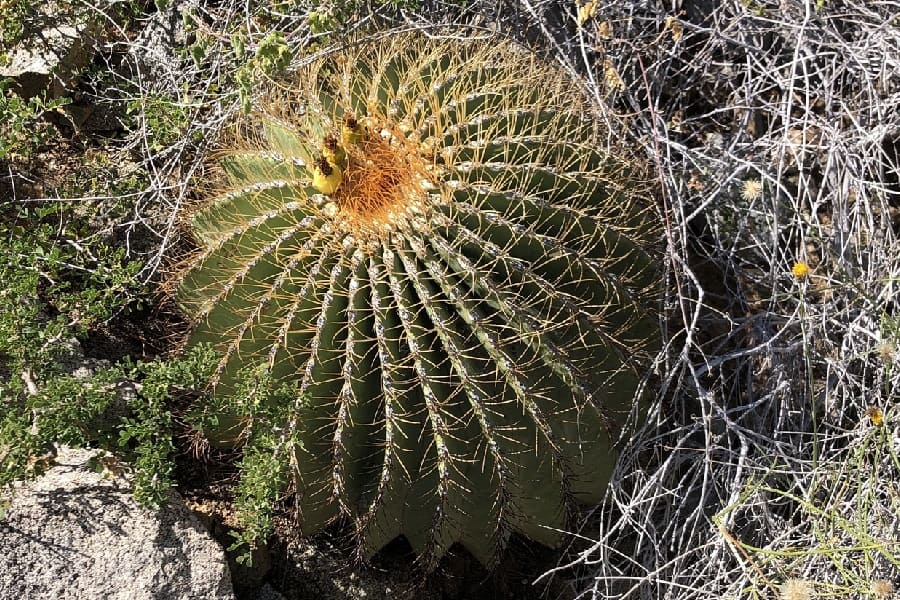
Ferocactus diguetii is a remarkable cactus that can grow up to 13 feet tall. It is one of the largest species of column-like cacti and usually forms a solitary column. The specimens from Santa Catalina are particularly impressive.
Ferocactus echidne
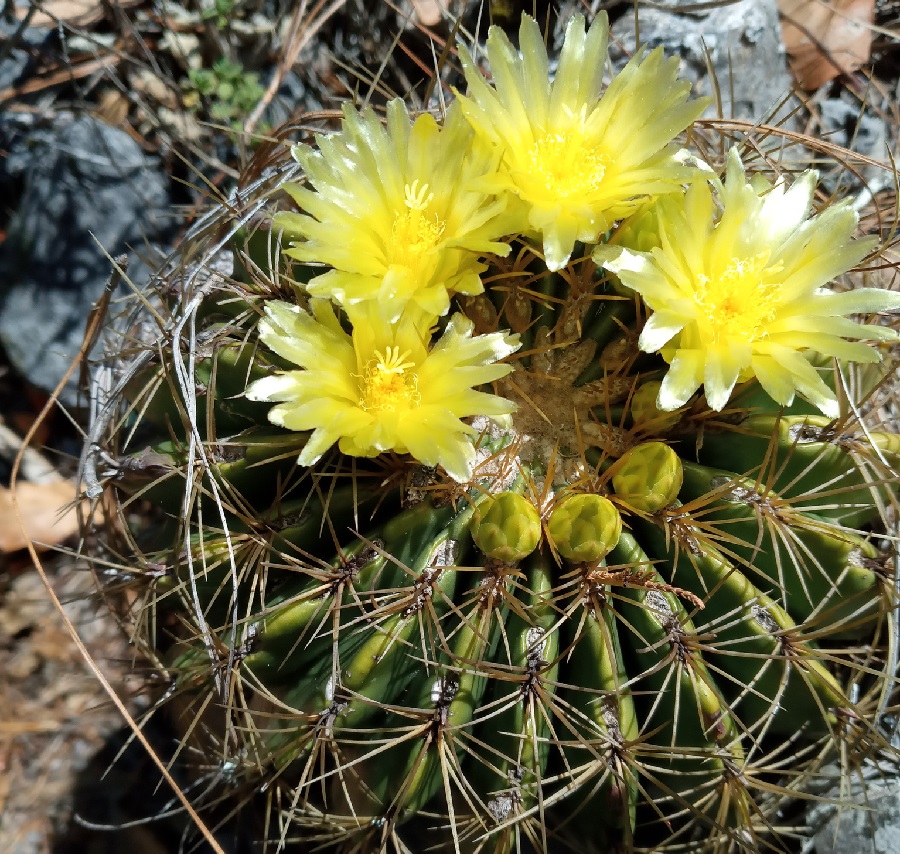
Ferocactus echidne is a medium-sized barrel cactus that usually grows alone, but sometimes has multiple stems when mature. There are two variations, but taxonomic clarification is needed. It might be confused with Ferocactus glaucescens.
Ferocactus echidne var. victoriensis
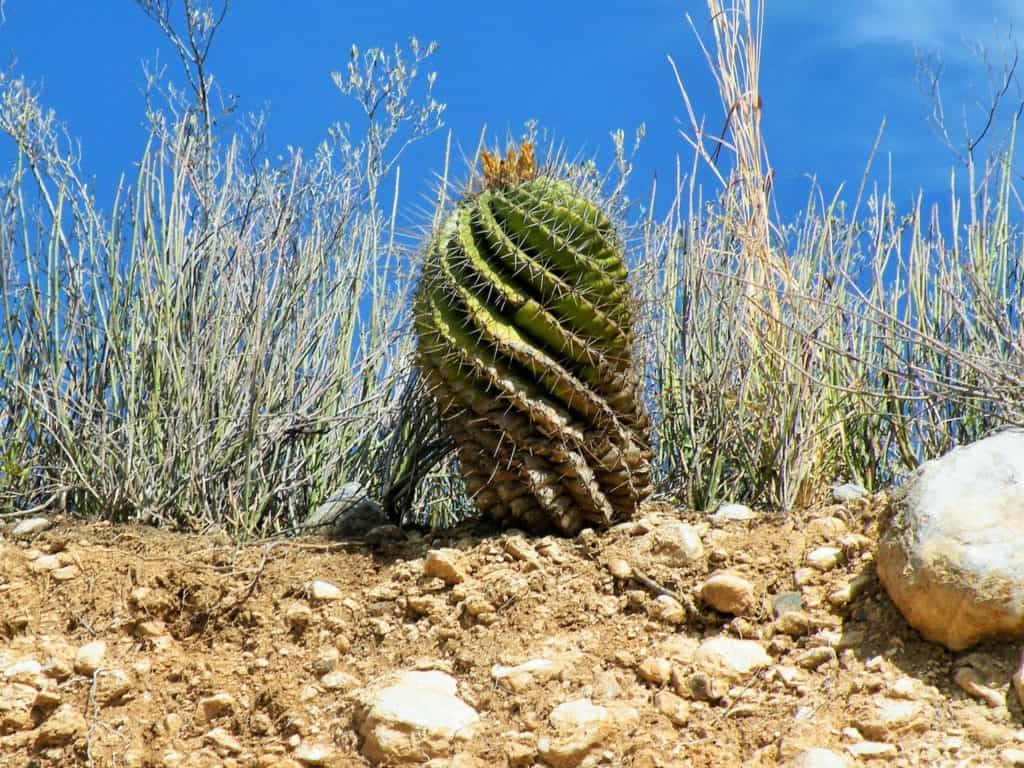
Ferocactus echidne var. victoriensis distinguishes itself from the standard Ferocactus echidne with its cylindrical stems and central spines longer than 1.5 inches.
Ferocactus emoryi (Emory’s Barrel Cactus)
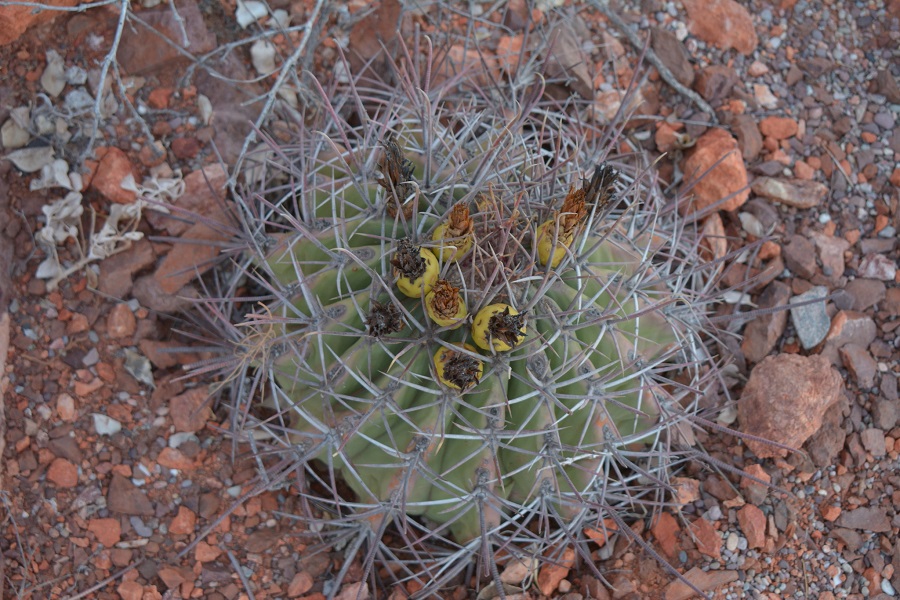
Ferocactus emoryi is a solitary barrel cactus, usually without lower radial spines. It closely resembles Ferocactus wislizenii and Ferocactus acanthodes but has its own distinct characteristics. There are three recognized subspecies.
Ferocactus emoryi ssp. rectispinus
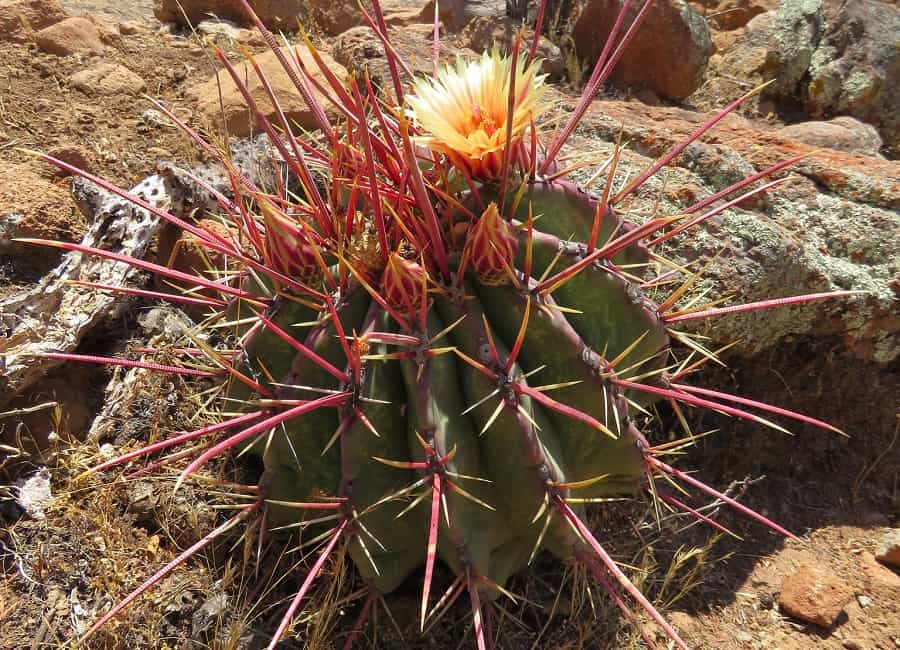
Ferocactus rectispinus is a solitary barrel cactus, typically remaining unbranched except in the case of an injury to the growing tip.
Ferocactus flavovirens
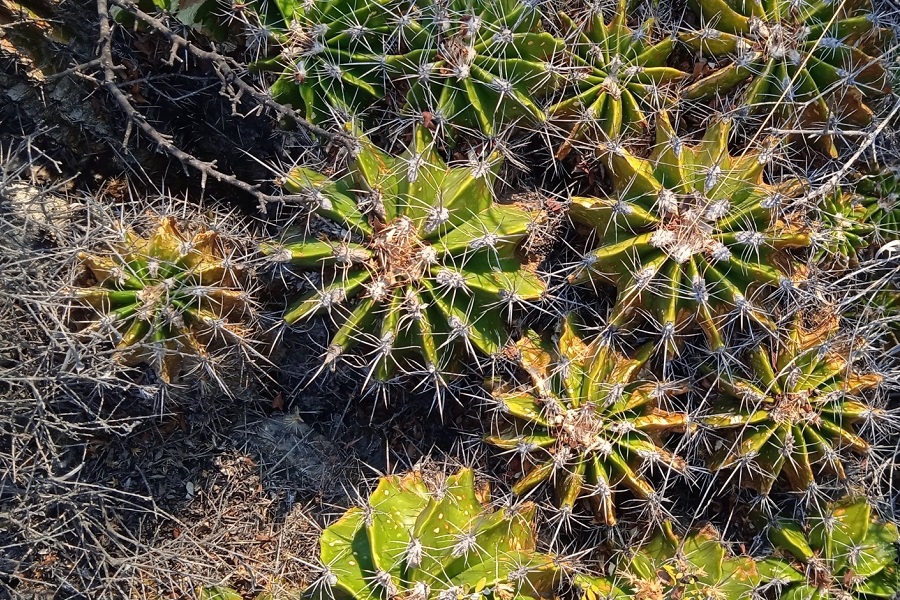
Ferocactus flavovirens starts as a solitary cactus but often forms large, multi-stemmed mounds up to 3.3 feet tall and over 6.5 feet wide. F. flavovirens is similar to Ferocactus robustus, but it has larger and fewer stems with more ribs and different spines.
Ferocactus fordii (Ford Barrel Cactus)
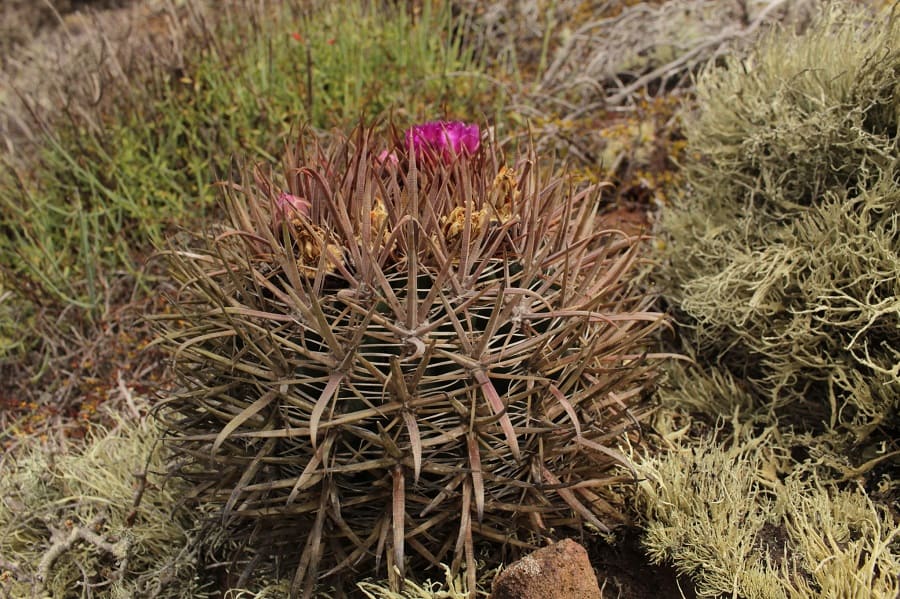
Ferocactus fordii is a small single-stemmed barrel cactus that occasionally offsets. It is similar to Ferocactus viridescens but slightly smaller. There are two recognized subspecies.
Ferocactus fordii ssp. borealis
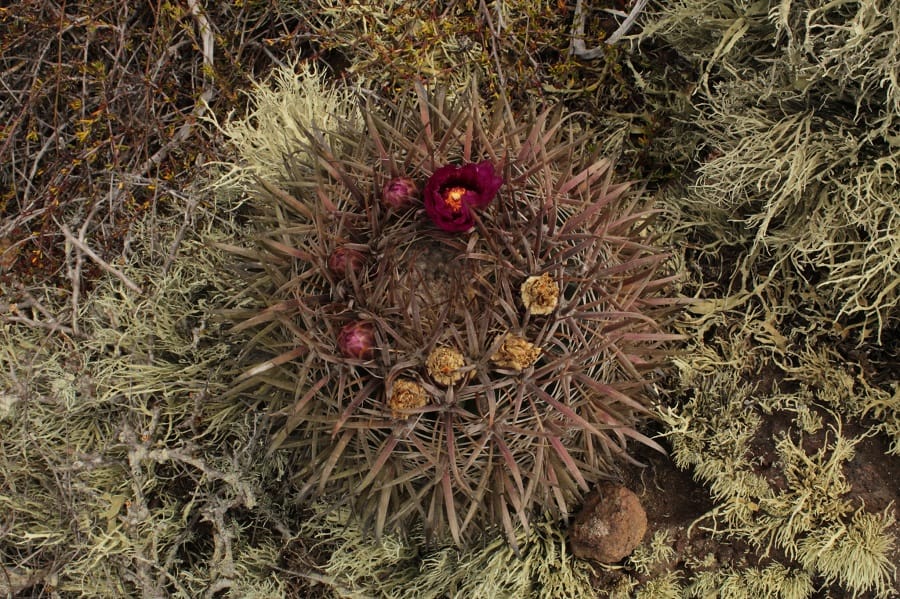
Ferocactus fordii ssp. borealis occurs one-third of the way down the Baja Peninsula, near the coast and near the road. It reaches a diameter of 8 inches when fully grown.
Ferocactus gracilis (Fire Barrel Cactus)
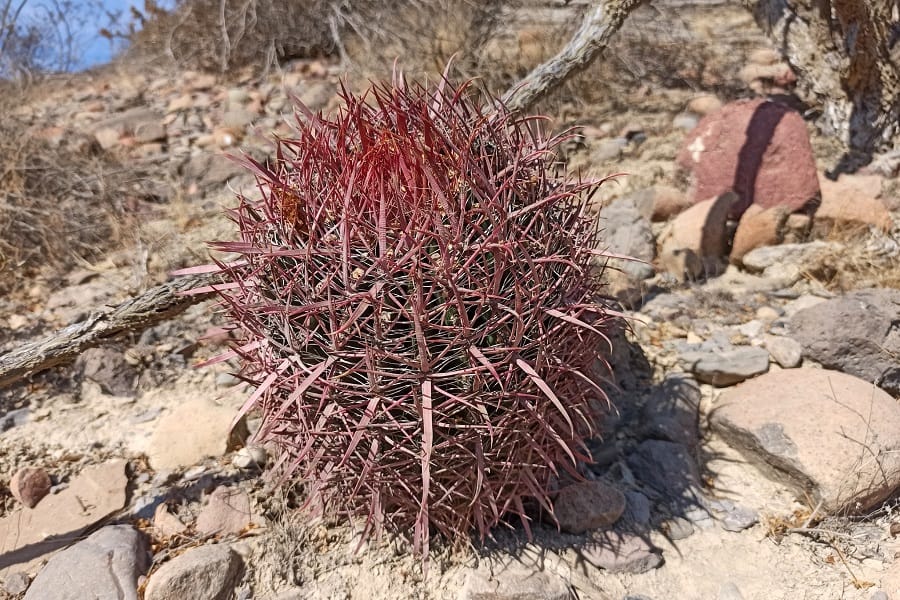
Ferocactus gracilis is a stunning barrel cactus with red spines, vibrant red flowers, and yellow fruit. It has stems up to 3.3 feet tall and has central spines less than 0.2 inches wide. It is distributed in northern central Baja California.
Ferocactus gracilis ssp. coloratus

Ferocactus gracilis ssp. coloratus is a particularly attractive cactus with shorter stems and shorter spines. The upper and lower of the four principal centrals are at least 0.2 inches wide, but often over 0.4 inches wide. The spines are similar to those of Ferocactus gracilis but with less red pigment. The seeds are angular, irregular, and slightly larger than those of gracilis.
Ferocactus gracilis ssp. gatesii
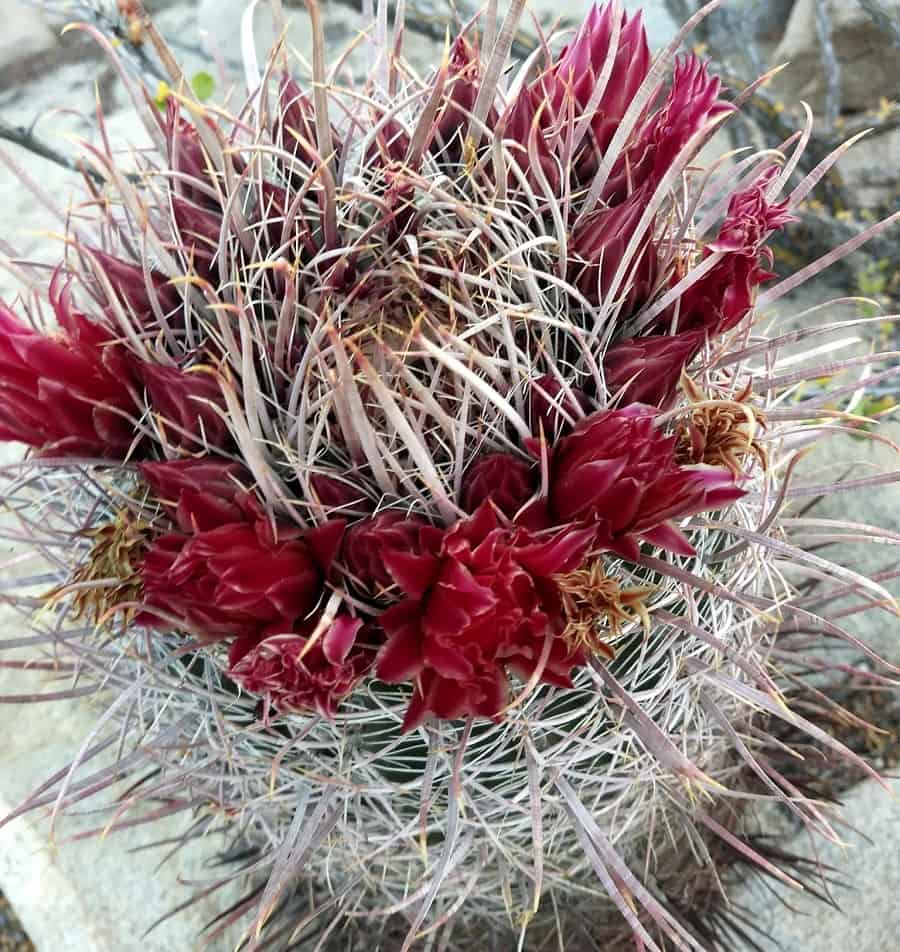
Ferocactus gracilis var. gatesii is a particularly attractive cactus with tall stems, more ribs (24-32), and shorter, curved but not hooked central spines measuring only 0.1 inches wide. It is closely related to the northern Ferocactus cylindraceus.
Ferocactus gracilis ssp. tortulispinus
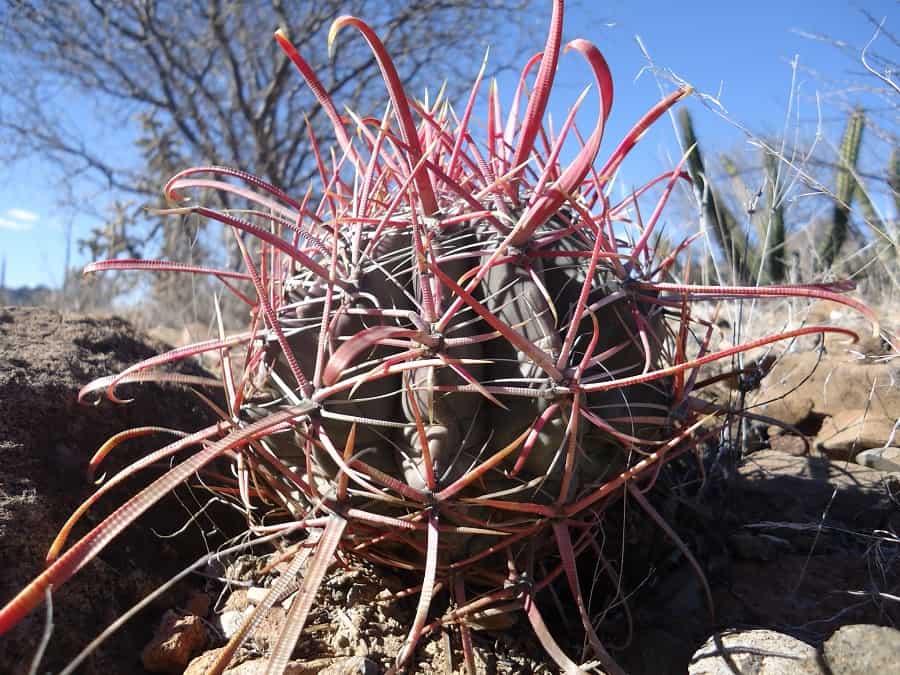
Ferocactus gracilis ssp. tortulispinus is a variant of Ferocactus gracilis with remarkably long hooked spines.
Ferocactus hamatacanthus (Turk’s head)
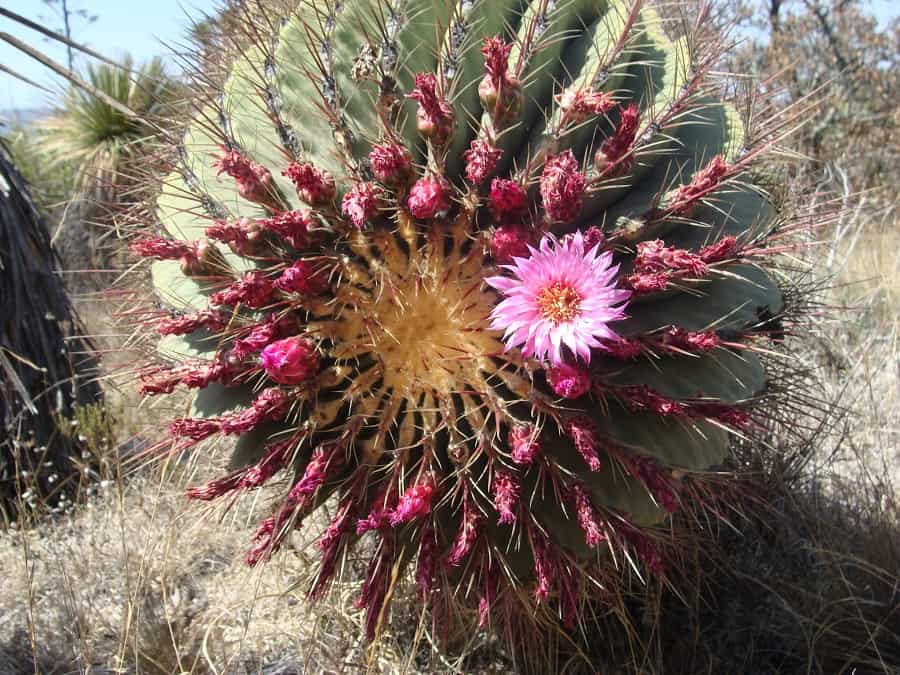
Ferocactus hamatacanthus is a medium-sized barrel cactus with varying numbers, diameters, and positions of spines depending on its origin. It has stems up to 2 feet tall, rounded ribs, and brownish-reddish spines. It is found in Southern Texas, New Mexico, and northern Mexico.
Ferocactus herrerae
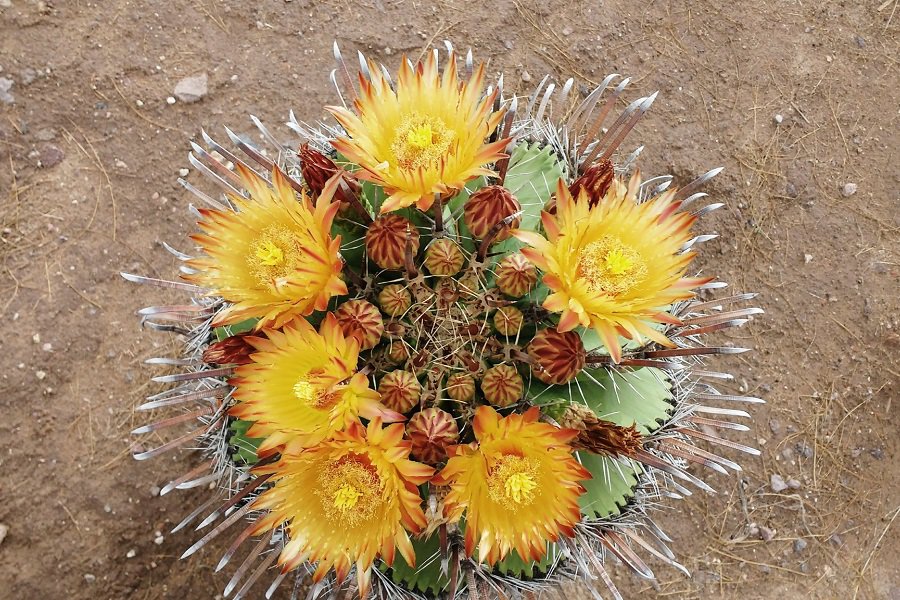
Ferocactus herrerae is a barrel-shaped cactus with strikingly long hooked spines.
Ferocactus histrix
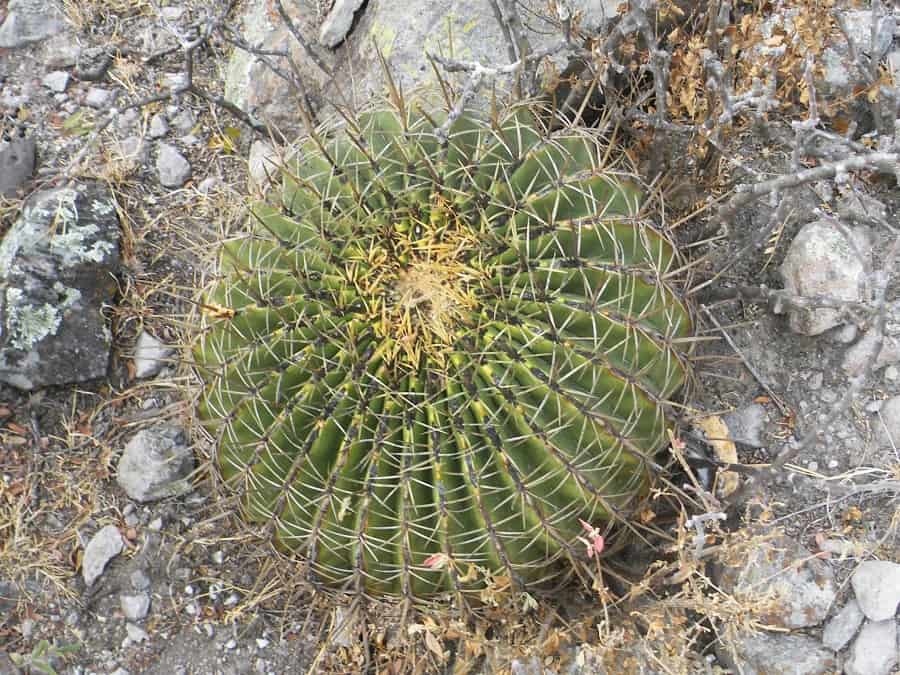
Ferocactus histrix is a colorful barrel cactus that usually grows as a single tall column up to 43 inches tall and 20-24 inches in diameter.
Ferocactus latispinus (Devil’s Tongue Barrel Cactus)
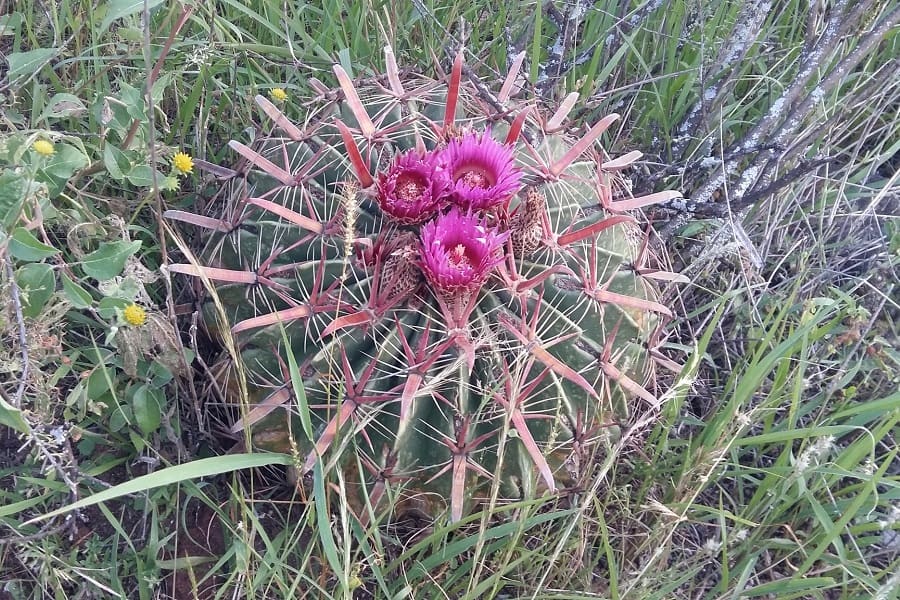
Ferocactus latispinus is a modest-sized barrel cactus and perhaps the most well-known species of Ferocactus. It has hemispherical or flat-topped stems, with 4 large red or grey-red central spines that can be hooked and reach up to 1.5 inches long. It is found in central and southern Mexico.
Ferocactus macrodiscus
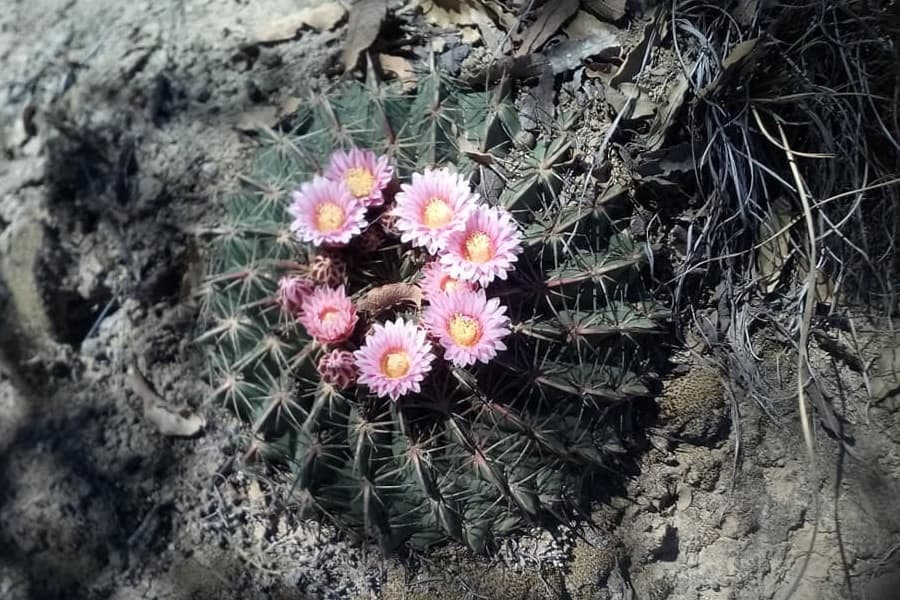
Ferocactus macrodiscus is a medium-sized barrel cactus with a depressed-globose stem and blue-green skin. Growth from seed is quite rapid, and plants will flower when only a few inches across. Flowers are white with pinkish-purple striped petals.
Two subspecies are recognized, the nominate form and ssp. septentrionalis with longer areoles measuring 0.2 to 1 inch. The spines are yellow or red and curved. The ‘macrodiscus’ subspecies is most prevalent.
Ferocactus macrodiscus ssp. septentrionalis
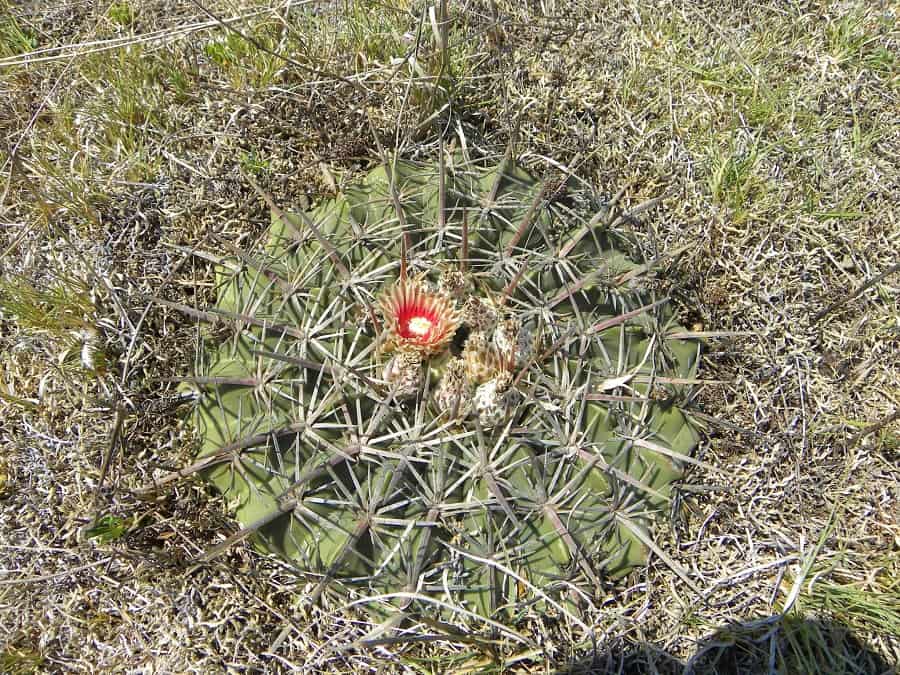
The ‘septentrionalis’ subspecies has a greenish-yellow skin with longer, straight, and strong spines. The areoles are 0.6 to 1 inch long.
Ferocactus peninsulae
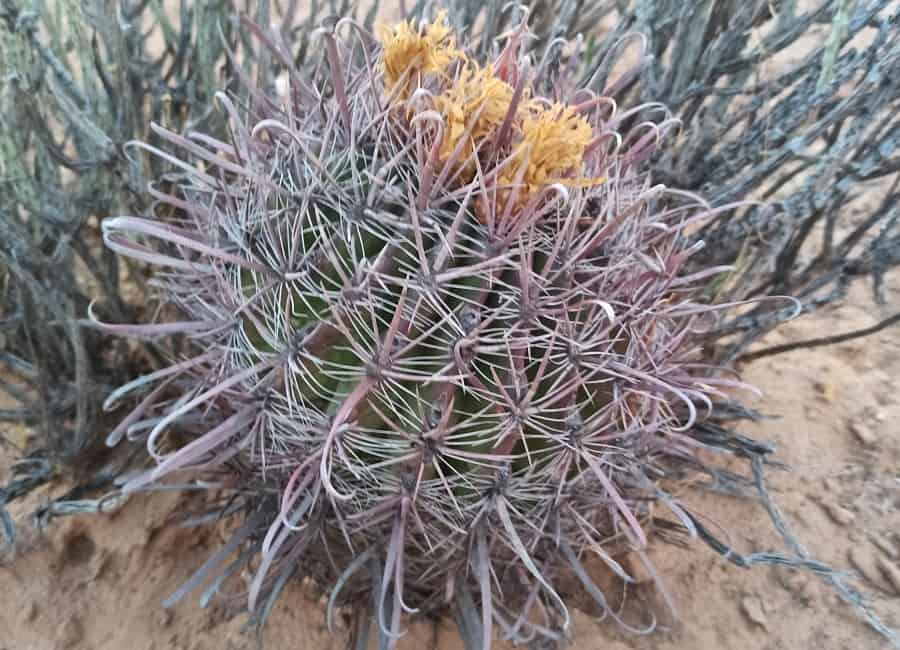
Ferocactus peninsulae is a large barrel cactus with ribs on its stem. It can grow up to 8 feet in height, which is unusual for this type of cactus. Its spines and flowers are similar to those of Ferocactus wislizeni. To tell the difference between cultivated plants of Ferocactus peninsulae and Ferocactus wislizeni var. herrerae, you need either the seeds or information about their origins.
Ferocactus peninsulae ssp. viscainensis
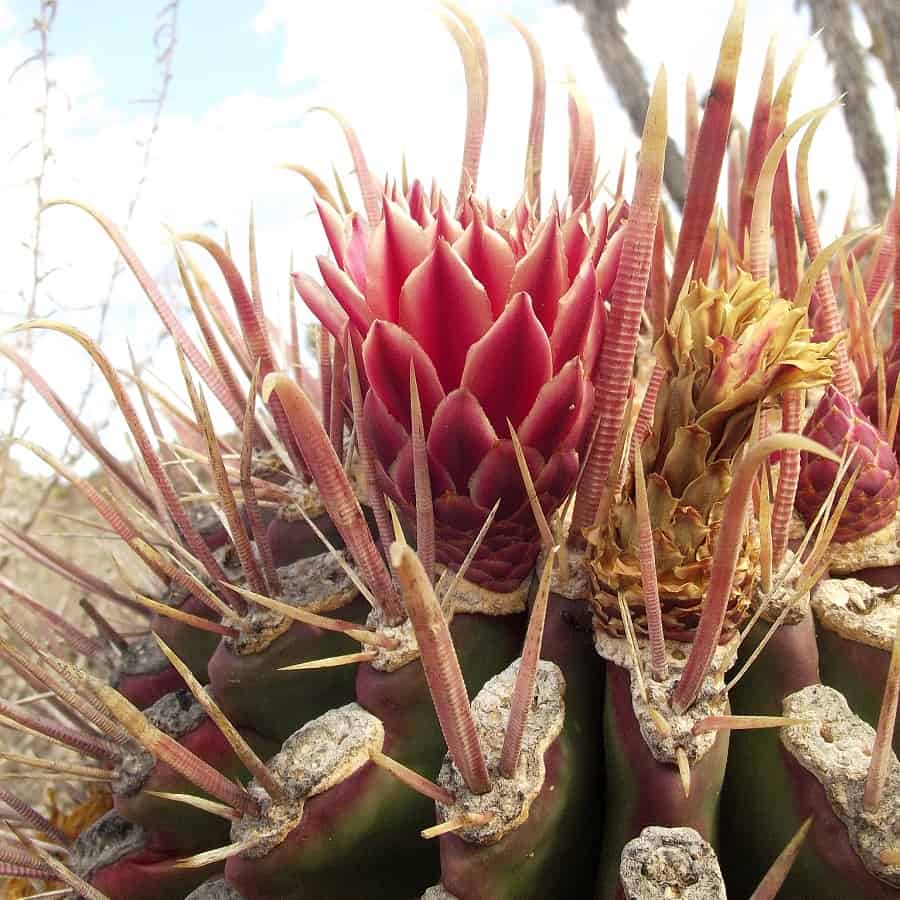
Ferocactus peninsulae subspecies viscainensis is a large barrel cactus that is often considered a separate species. It stands out with its dull olive-green body, more ribs (13-21) that are distinctly tuberculate, thin, deep, and undulate. Some people think it is the same as Ferocactus gracilis.
Ferocactus pilosus
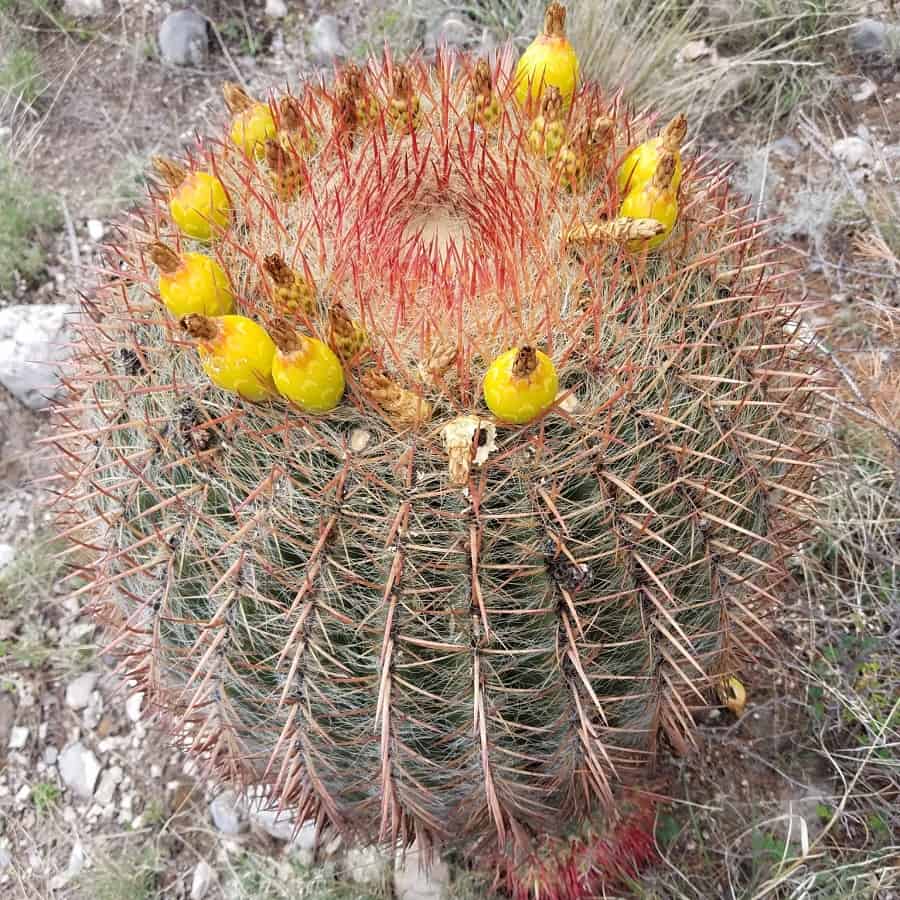
Ferocactus pilosus is a cactus that forms a single barrel or multiple columns. It has thick red spines. In the wild, these cacti can grow for a long time, forming groups with several subsidiary barrels growing from the main one. The deep green bodies are densely covered with bright red spines.
Ferocactus pottsii
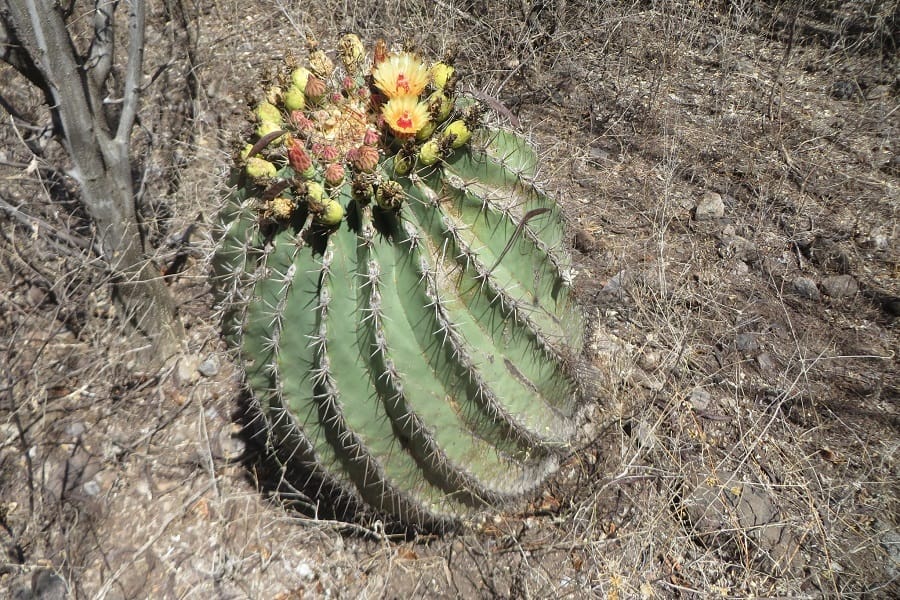
Ferocactus pottsii is a small barrel cactus that usually grows alone, but sometimes in clusters at the base.
Ferocactus recurvus
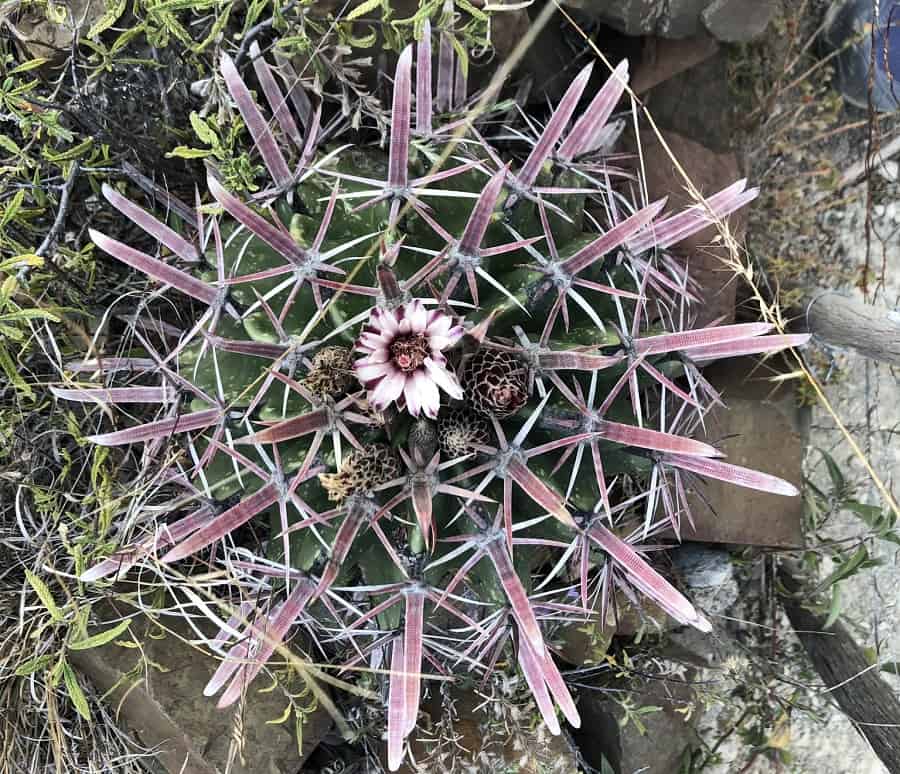
Ferocactus recurvus is a modest-sized barrel cactus that blooms in the winter. Its stem is more elongated or cylindrical compared to the standard Ferocactus latispinus. It has fewer and stouter radial spines and only one longer central spine.
Ferocactus recurvus ssp. greenwoodii
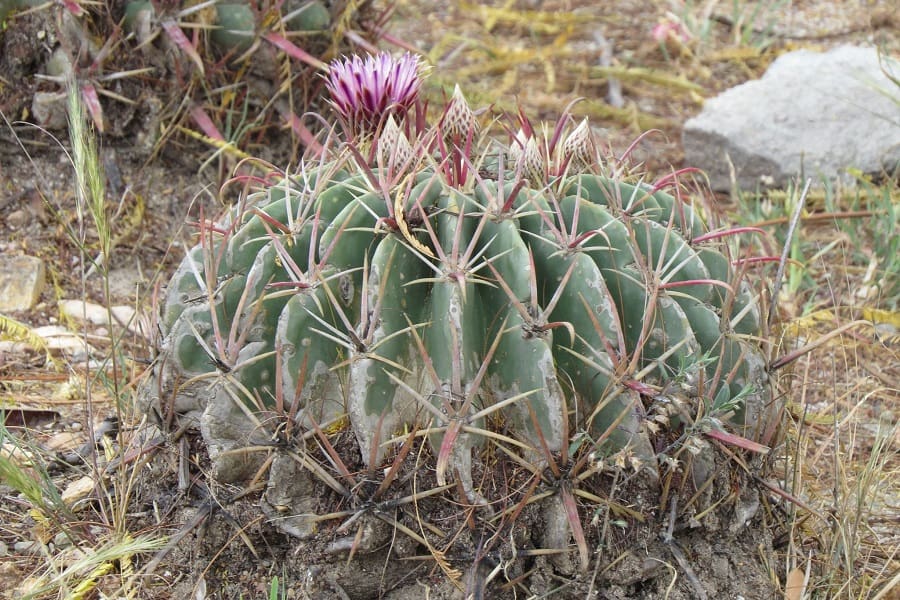
Ferocactus recurvus ssp. spiralis
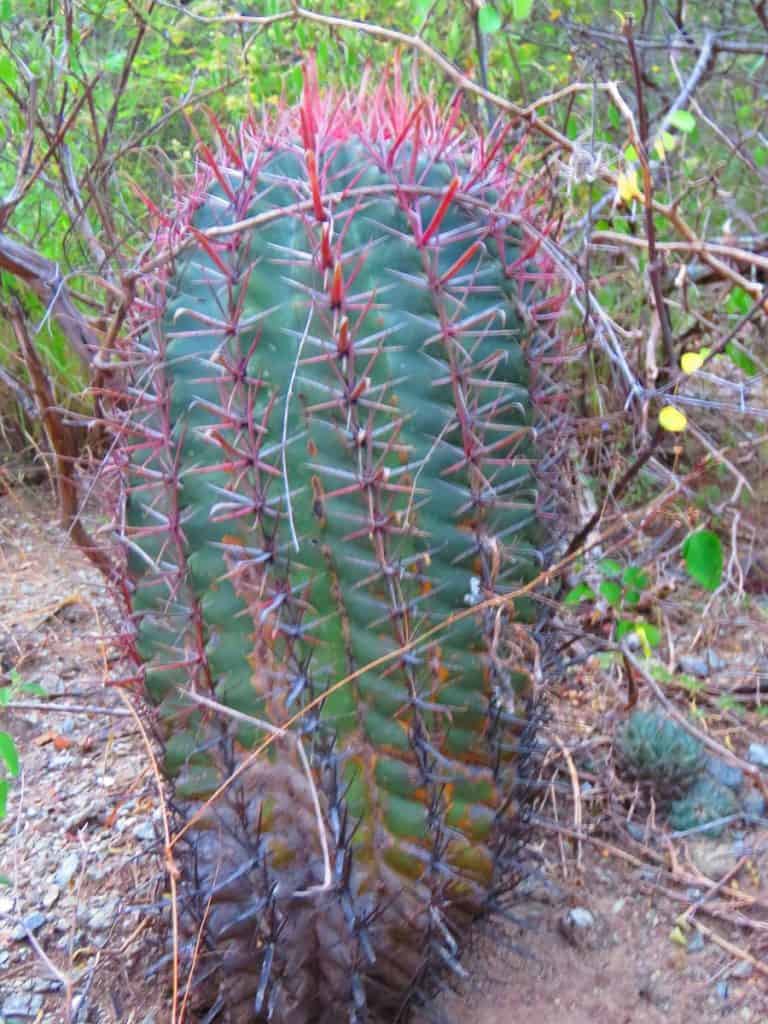
Ferocactus reppenhagenii
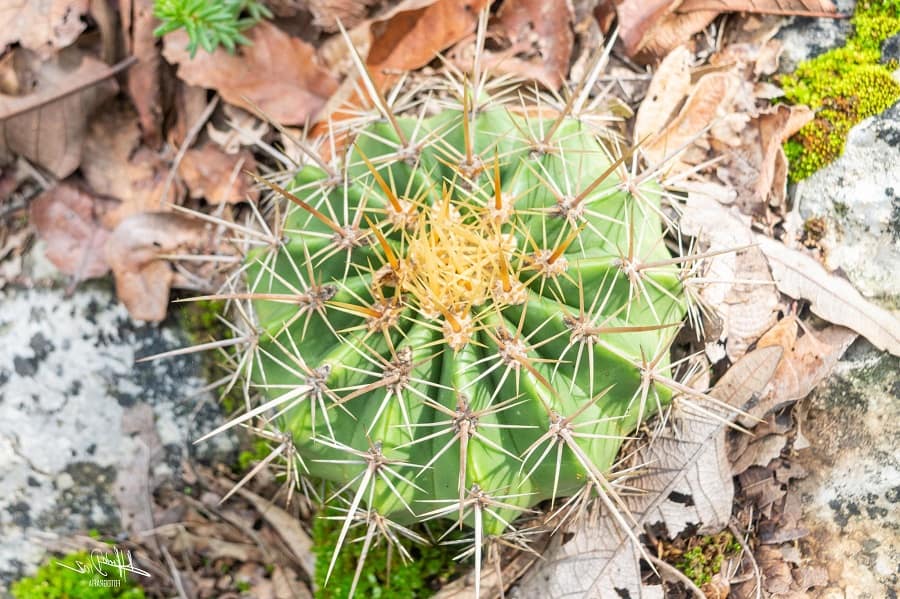
Ferocactus reppenhagenii is a small cactus with a small diameter. It looks nearly columnar and has less than 13 ribs. In contrast, Ferocactus alamosanus looks large and globular with many ribs (more than 20).
Ferocactus robustus
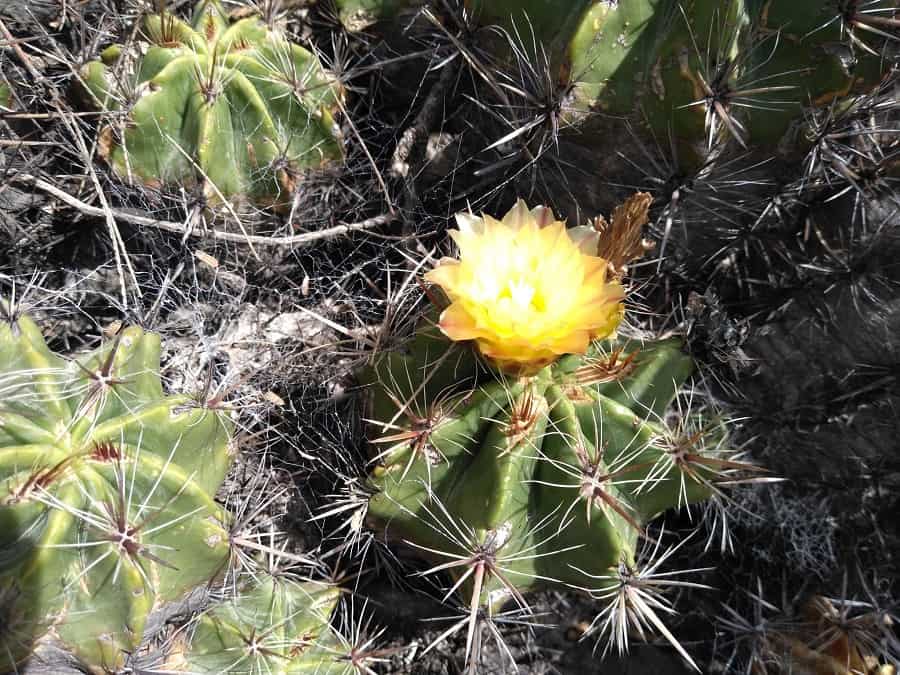
Ferocactus robustus is a clumping barrel cactus that forms large colonies with hundreds of branches. These clusters can grow over 3 feet tall and 10-16 feet wide. This unique habit is unlike any other species in the genus. The clusters are believed to develop from seedling plants that grow up around the parent, forming powerful colonies.
Ferocactus santa-maria
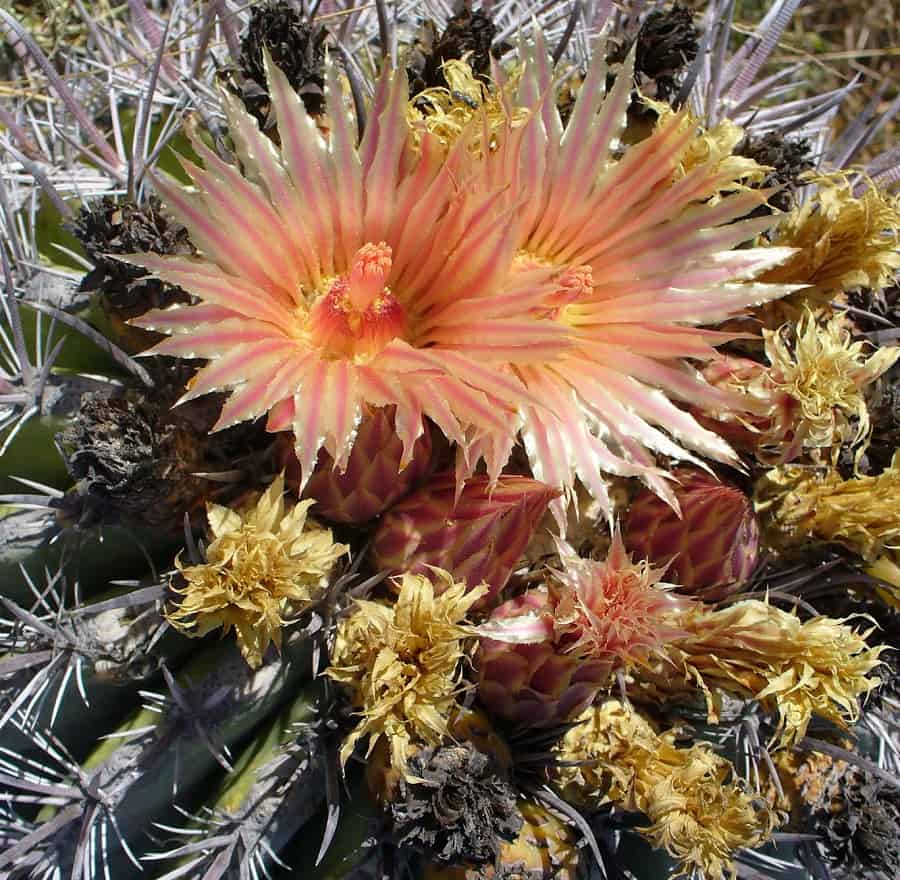
Ferocactus schwarzii
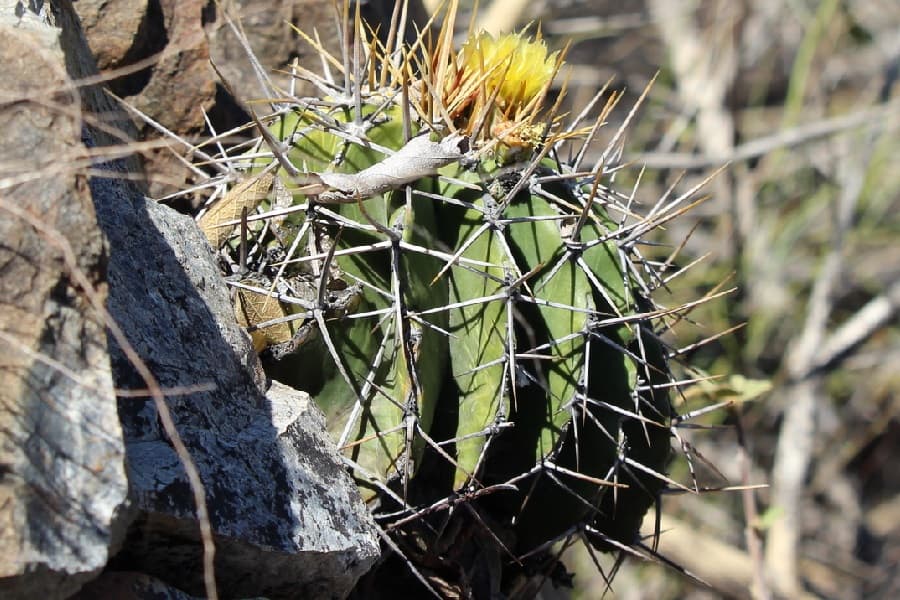
Ferocactus schwarzii is a slow-growing barrel cactus that becomes nearly spineless as it ages, giving it an attractive appearance. At first glance, mature specimens may resemble Echinocactus more than Ferocactus. Its stem is deeply grooved and bright green, reaching up to 31 inches in height and 20 inches in width.
Ferocactus stainesii
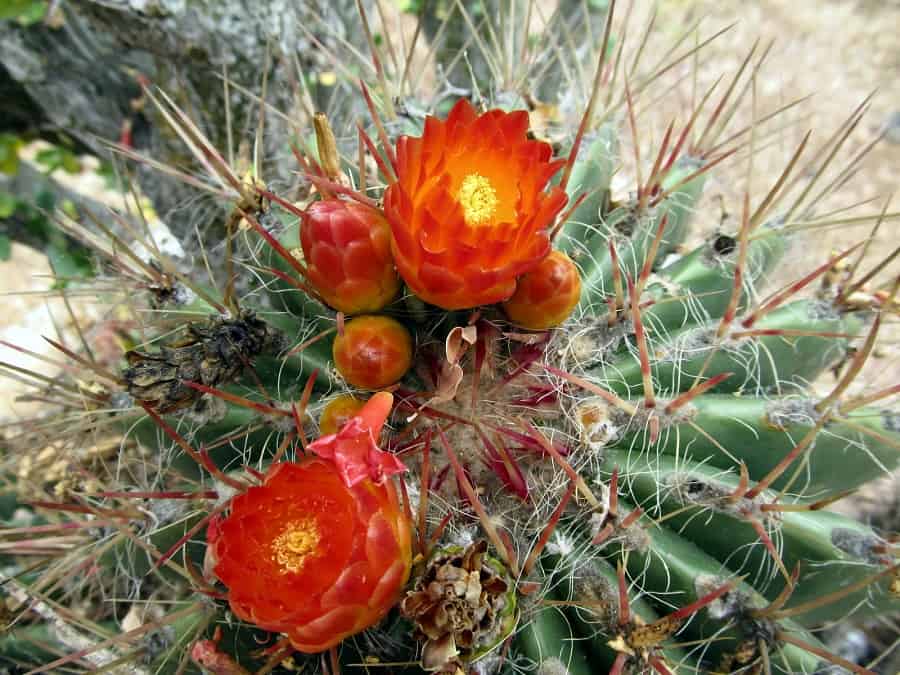
Ferocactus pilosus is still commonly referred to as Ferocactus stainesii by commercial growers, but many experts do not consider it distinct enough to be its own variety or species. They believe there is no fundamental difference between the two plants.
Ferocactus tiburonensis
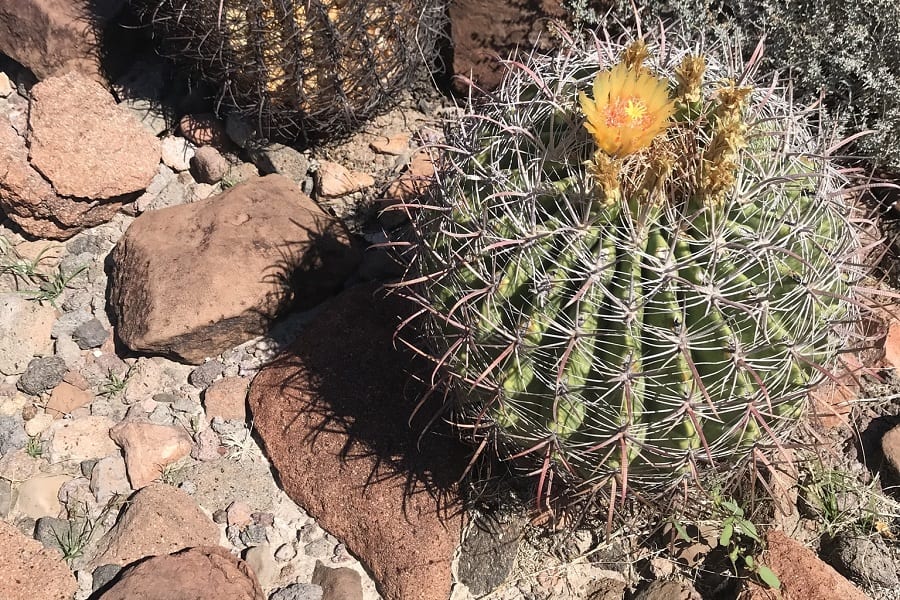
Ferocactus townsendianus
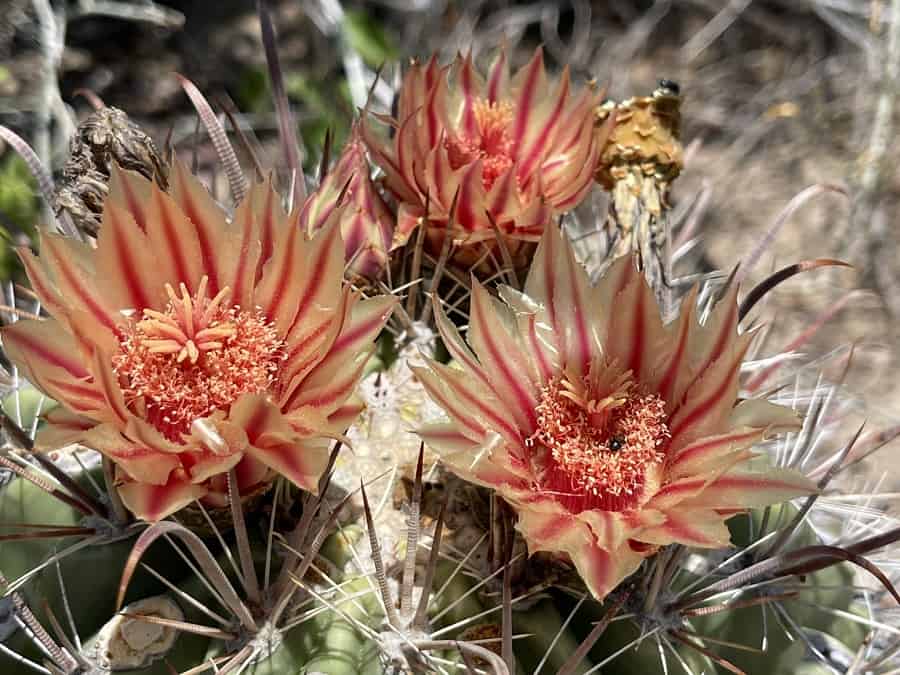
Ferocactus townsendianus var. townsendianus
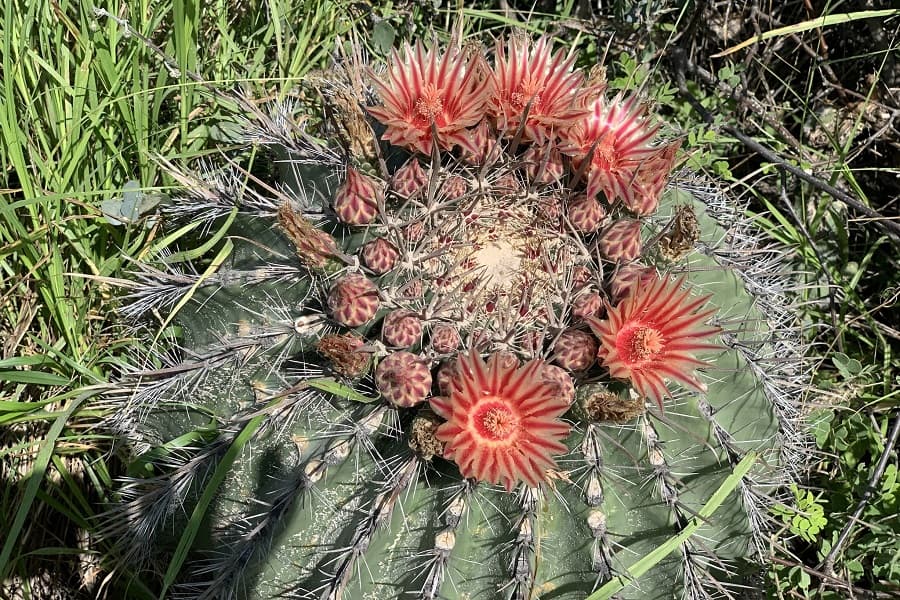
Ferocactus viridescens (San Diego Barrel Cactus)
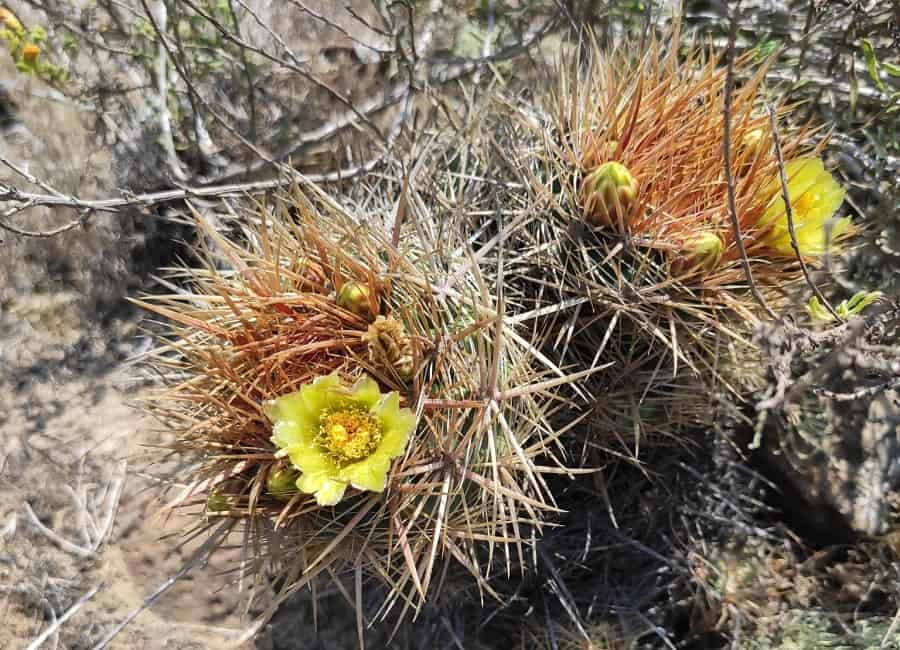
Ferocactus viridescens is a solitary barrel cactus that is sometimes wider than it is tall. Its stems are shorter than those of Ferocactus cylindraceus, but the taxonomic distinctions between the two species are not clear. In California, Ferocactus viridescens and Ferocactus cylindraceus are found in different areas.
Without geographic data, it can be challenging to distinguish the largest plants of Ferocactus viridescens from fully grown plants of Ferocactus cylindraceus with straight spines. Immature plants of Ferocactus cylindraceus have mostly or entirely hooked spines, but they gradually produce straighter spines as they age.
Ferocactus viridescens ssp. littoralis
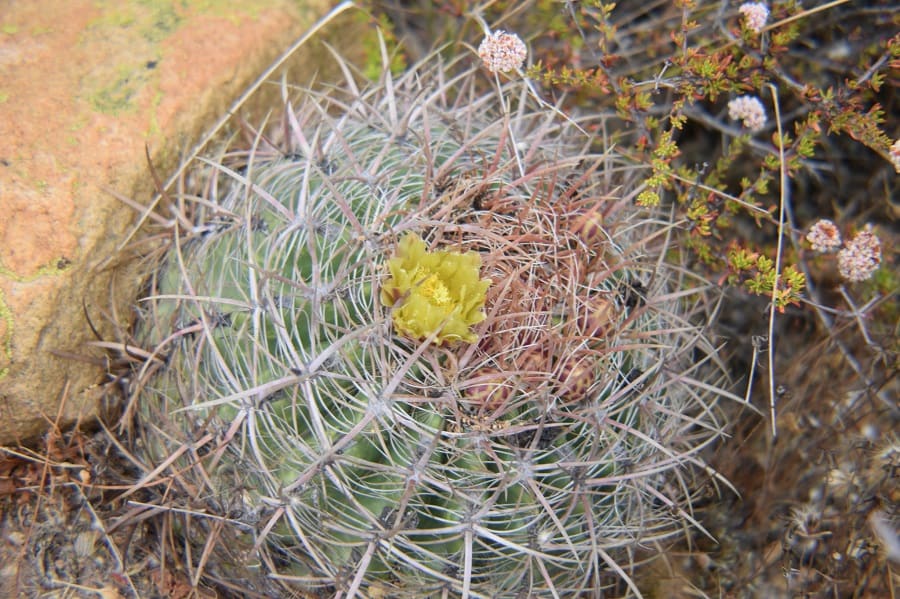
The ‘littoralis’ variety of Ferocactus viridescens has 21-34 ribs without tubercles. Each areole has 21-34 spines. It is found only along the west coast of Baja California down to Mission Santo Domingo.
Ferocactus viridescens ssp. viridescens
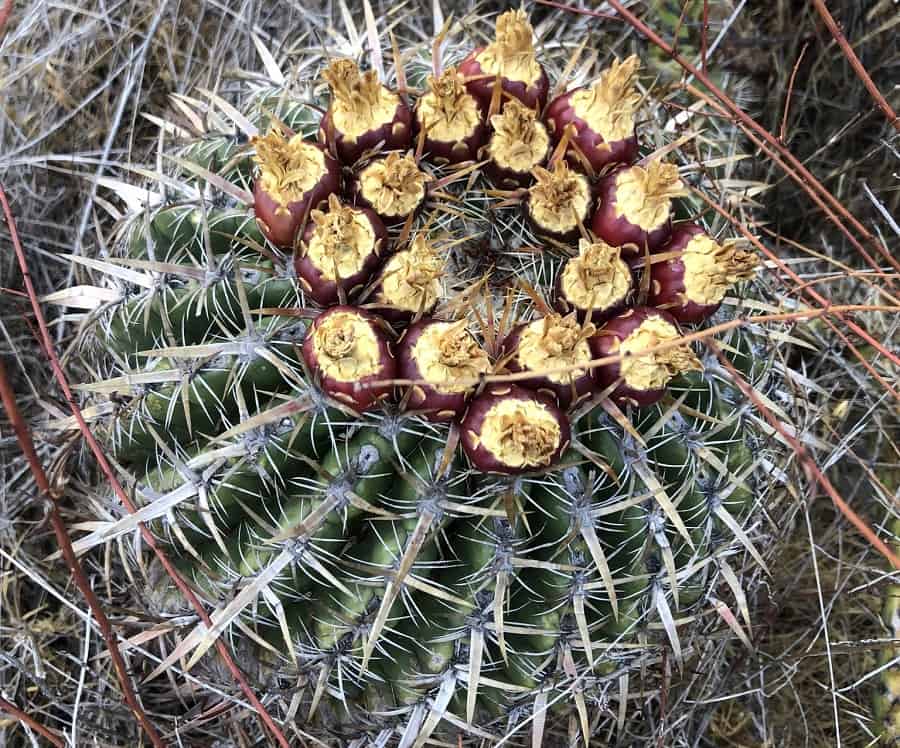
The ‘viridescens’ variety of Ferocactus viridescens has 13-25 tuberculate ribs and 15-25 spines per areole.
Ferocactus viscainensis
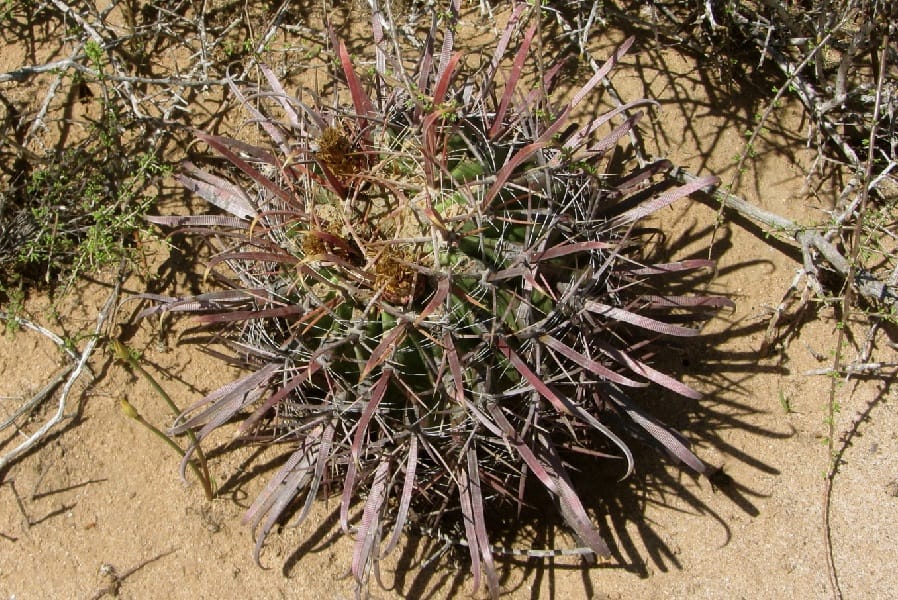
Ferocactus wislizeni (Fishhook Barrel Cactus)
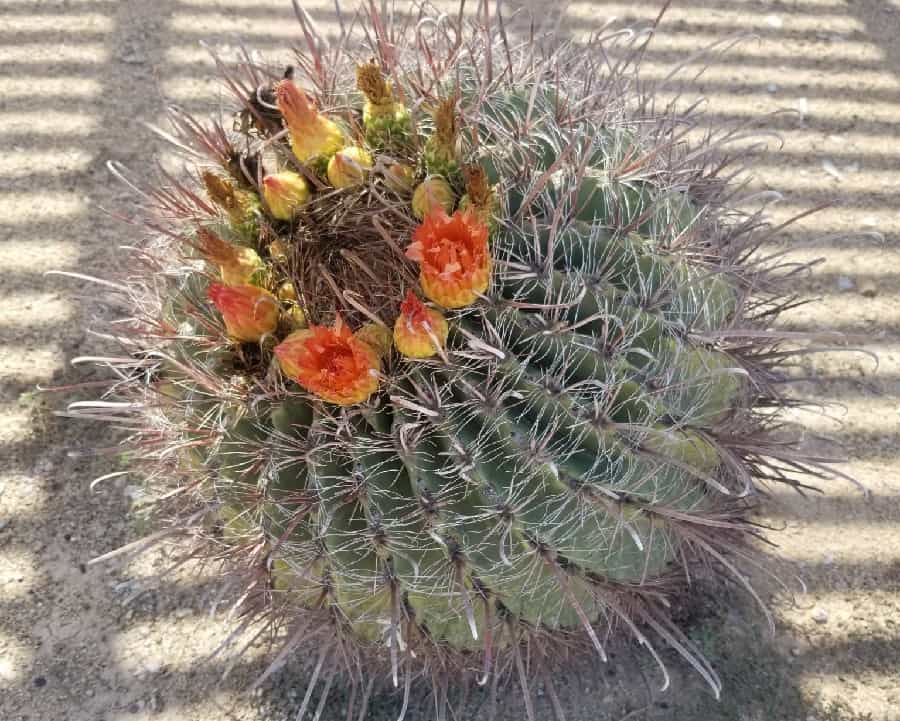
The fishhook barrel cactus (Ferocactus wislizeni) is a barrel-shaped or columnar cactus that usually grows as a single column. Some rare specimens may have multiple columns. It typically reaches a diameter of 20-31 inches and a height of 3-6 feet. However, some individuals can grow as tall as 10 feet.
The lifespan of this cactus can range from 50 to 130 years. In its natural habitat, it often leans southward toward the equator, earning the nickname “compass barrel cactus.” Older barrels can lean so much that they uproot themselves, especially after heavy rains when the loose soil allows them to topple over. The flowers are yellow to red-orange and appear on top of the cactus fruit during the summer months. Its common name comes from the thick and hooked spines.
Ferocactus wislizeni ssp. ajoensis

Ferocactus wislizeni subsp. ajoensis refers to a form of Ferocactus wislizeni with very long spines. The name ajoensis is derived from the town of Ajo, which is the type locality of this species.
It is distinguished from the typical subspecies of F. wislizeni by its slender, columnar body, longer and denser spines, as well as an earlier and longer flowering period during the summer months. Some taxonomists might not recognize this subspecies, but it looks interesting and noticeably different from the typical wislizeni type.
Read also:
1,000 Types of Cactuses with Pictures
How to Grow and Care For Ferocactus
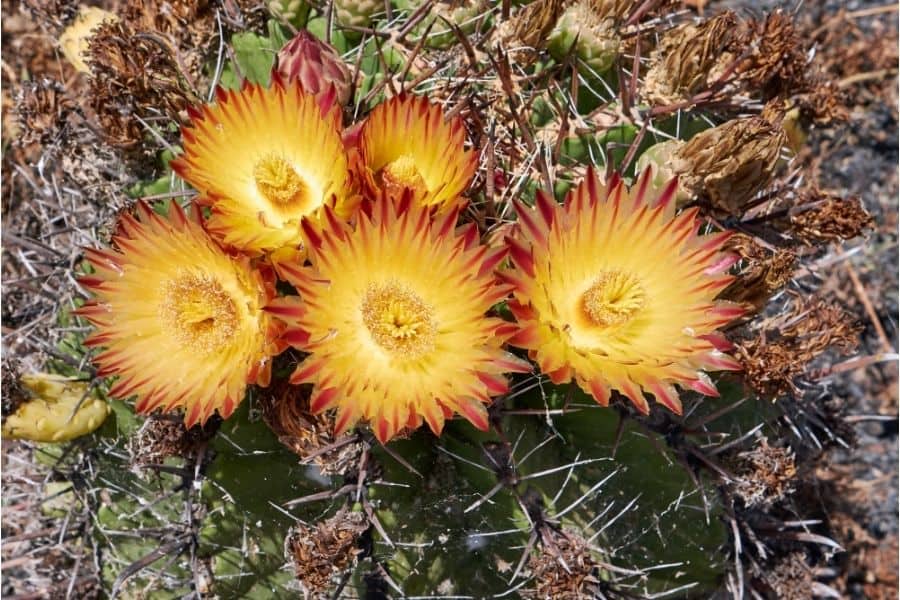
Ferocactus is not only beautiful but can also last for over a century. These cacti can reach heights of 2 to 10 feet and have a globular shape when young, turning cylindrical as they mature. If you’re fascinated by the unique shape and size of Ferocactus and want to bring it into your home, it’s important to learn how to care for it properly.
Here are some essential tips to help you take care of your Ferocactus:
Light
Ferocactus loves sunlight, so it’s crucial to provide it with plenty of sun exposure. While partial shade won’t harm the plant, it’s important to keep the environment warm overall. In winter when sunlight is limited, you can use grow lights to supplement the lack of natural sunlight, while also protecting the cactus from frost and mist.
Watering
Young Ferocactus plants need a bit more water and care compared to older ones. Generally, Ferocactus doesn’t require frequent watering due to its ability to store water efficiently. During the growing season (spring to fall), water the plant regularly. In winter, when temperatures drop, reduce the amount of watering significantly. Only water the plant when the topsoil has completely dried out to prevent soil saturation, which can harm the cactus.
Soil
Well-draining soil is crucial for Ferocactus. Ensure there are sufficient drainage holes at the bottom of the container to allow excess water to flow out. Regular cacti mix is suitable for Ferocactus, or you can create your own mix using 45% pumice, 40-45% compost, and sand. Adding some decomposed granite and pebbles around the pot can mimic its natural habitat and add visual appeal.
Climate
Ferocactus thrives in dry and arid climates, resembling its natural desert habitat. It is sensitive to frost and prefers warmer temperatures. Creating desert-like conditions will help your Ferocactus grow and thrive.
Fertilizing
Ferocactus grows well in low-nutrient conditions, so aggressive fertilizing is not necessary. However, you can use a low-hydrogen fertilizer once a year before the growing season to support its growth.
Propagating Ferocactus
Propagating Ferocactus species is fairly easy. Once you have done the hard work, you can simply sit back and relax because Ferocactus doesn’t have a lot of maintenance needs.
- Prepare the soil at home by taking sand, perlite, and compost so that the soil is well-draining. Alternatively, you can even go with a cacti potting mix. Add a very small amount of fertilizer, but don’t go overboard.
- Take a small cutting from the main stem of the Ferocactus species and place it in the potting mix.
- Keep the soil moist and let the Ferocactus grow. You will need to be patient because these are slow-growing cacti.
Once you have propagated the cuttings, do not water the container for at least a week or two. This is to give the Ferocactus species a near-native growing environment. Also, do not expose the container to harsh sunlight at the very outset. Partial shade or bright (not scorching) sunlight is ideal.
Sometimes people also propagate Ferocactus species with seeds, but cuttings work better.
FAQs
How fast does Ferocactus grow?
Ferocactus grows slowly, testing your patience. It can take several years or even decades to reach its full height. This slow growth contributes to its long lifespan.
Final Words
With these guidelines, you’ll be well-equipped to care for your Ferocactus and enjoy its unique beauty. Remember, patience is key when growing these cacti!
